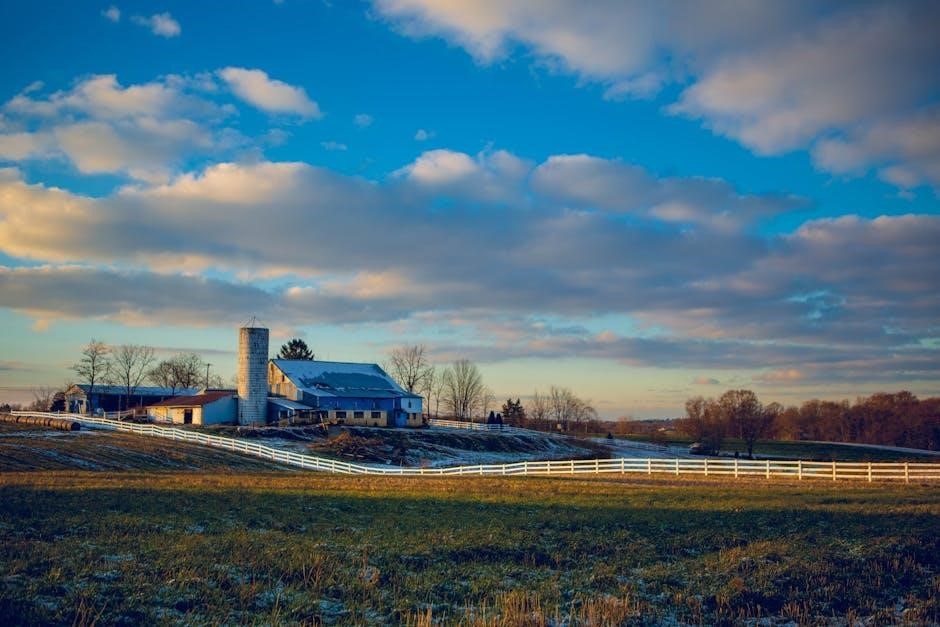
field guide to american houses
The guide to American houses provides comprehensive information on domestic architecture, including historical context and architectural styles, with detailed descriptions and photographs of various house types and designs available online.
Overview of the Field Guide
The field guide to American houses is a comprehensive resource that provides an in-depth look at domestic architecture, with a focus on identifying and understanding various house styles and designs.
The guide includes a wide range of information, from historical context to architectural details, and features a vast collection of photographs and line drawings.
The field guide is designed to be a definitive reference for anyone interested in American houses, and its detailed descriptions and illustrations make it an essential tool for architects, historians, and homeowners alike.
With its comprehensive coverage and user-friendly format, the field guide is an invaluable resource for anyone looking to learn more about American domestic architecture.
The guide’s detailed information and extensive collection of images make it a unique and valuable resource for anyone interested in this topic.
The field guide is widely acclaimed and has been recognized as a essential guide to American houses.
History of the Field Guide
The field guide to American houses was first published in 1984 and has since become a widely acclaimed and essential reference for domestic architecture.
The guide was written by Virginia and Lee McAlester, who are renowned experts in the field of architectural history.
The authors’ extensive research and knowledge of American houses are reflected in the guide’s comprehensive coverage of various house styles and designs.
The field guide has been in print for over three decades and has undergone several updates and revisions to reflect new research and discoveries.
The guide’s publication history is a testament to its enduring value and importance as a resource for architects, historians, and homeowners.
The field guide’s impact on the field of architectural history is significant, and it continues to be a widely used and respected reference today.
The guide’s history is closely tied to the development of American domestic architecture, and its influence can be seen in many areas of architectural study.

Types of American Houses
Diverse American house types include folk, colonial, and other styles, each unique and historically significant, with various characteristics and features, as outlined in the field guide to American houses online.
Folk Houses
Folk houses are a type of American house that has a rich history and cultural significance, with various styles and designs that reflect the regional and ethnic backgrounds of their builders, as discussed in the field guide to American houses.
The guide provides detailed information on the characteristics and features of folk houses, including their materials, construction methods, and architectural details, which are essential for understanding and identifying these unique houses.
Folk houses can be further categorized into different sub-types, such as Native American, pre-railroad, and national styles, each with its own distinct characteristics and historical context.
The field guide to American houses provides a comprehensive overview of folk houses, including their evolution, regional variations, and cultural significance, making it an essential resource for anyone interested in American domestic architecture.
With its detailed descriptions, photographs, and line drawings, the guide is an invaluable tool for identifying and understanding folk houses, and their place in the broader context of American houses.
Colonial Houses
Colonial houses are a style of American house that originated during the colonial period, characterized by their classical proportions, symmetrical facades, and traditional materials, as described in the field guide to American houses.
The guide provides detailed information on the history and development of colonial houses, including their regional variations and architectural features, such as pilasters, pediments, and ornate woodwork.
Colonial houses can be found in various parts of the country, particularly in the Northeast, where they were influenced by European styles and adapted to the local climate and materials.
The field guide to American houses offers a comprehensive overview of colonial houses, including their evolution, notable examples, and cultural significance, making it an essential resource for understanding this important style of American domestic architecture.
With its detailed descriptions and photographs, the guide helps to identify and appreciate the unique characteristics of colonial houses, and their contribution to the rich heritage of American houses.

Architectural Styles
Guide to American houses covers various architectural styles, including modern and traditional designs, with detailed descriptions and photos of each style, providing a comprehensive overview of American domestic architecture online.
Style and Form
The field guide to American houses explores the concept of style and form in domestic architecture, examining the ways in which different styles, such as modern and traditional, are expressed through various forms and designs.
The guide provides a detailed analysis of the relationship between style and form, discussing how different architectural elements, such as roofs, windows, and doors, contribute to the overall style and form of a house.
With numerous examples and illustrations, the guide helps readers to understand the complexities of style and form in American domestic architecture, and to appreciate the unique characteristics of different architectural styles.
By examining the intersection of style and form, the guide provides a comprehensive understanding of American houses, and helps readers to identify and appreciate the various architectural styles that are found throughout the country.
Structure and Design
The field guide to American houses delves into the structure and design of domestic architecture, discussing the various components that make up a house, including foundations, walls, and roofs.
The guide examines the different design elements, such as symmetry and asymmetry, and how they contribute to the overall structure and aesthetic of a house.
It also explores the use of various materials, such as wood and brick, and how they impact the structure and design of a house.
With a focus on the technical aspects of house construction, the guide provides a detailed understanding of the structure and design of American houses, and helps readers to appreciate the complexities of domestic architecture.
The guide’s discussion of structure and design provides a comprehensive framework for understanding the construction and composition of American houses, and is an essential resource for anyone interested in domestic architecture.

Neighborhoods and Locations
Urban and suburban areas have distinct characteristics, influencing house designs and architectures significantly always.
Urban and Suburban Neighborhoods
Urban and suburban neighborhoods have unique characteristics that influence house designs and architectures, with a focus on community and proximity to amenities.
The layout of these neighborhoods often features a mix of housing types, including single-family homes, apartments, and condominiums, with varying architectural styles and designs.
In urban areas, houses may be built closer together, with an emphasis on maximizing space and utilizing vertical construction, such as multi-story buildings and row houses.
Suburban neighborhoods, on the other hand, tend to have more spacious lots and a greater emphasis on lawn and garden space, with houses often featuring porches, patios, and other outdoor living areas.
Overall, urban and suburban neighborhoods offer a diverse range of housing options, each with its own distinct character and advantages, and are an important part of the American housing landscape, with many examples and photos available online for reference and research purposes.
Rural Locations
Rural locations have distinct housing characteristics, shaped by the natural environment and available resources, with a focus on self-sufficiency and connection to the land.
Houses in rural areas often feature large lots, outbuildings, and expansive outdoor spaces, such as farms, ranches, and country estates.
The design of rural houses may incorporate local materials, such as wood, stone, and brick, and may feature traditional architectural styles, like farmhouses and country cottages.
Rural locations also often have limited access to amenities and services, which can influence house design and construction, with an emphasis on practicality and durability.
The field guide to American houses provides valuable insights and information on rural housing, including photos, descriptions, and examples of different house types and styles, helping to understand and appreciate the unique characteristics of rural locations and their housing stock, with many examples available for study and reference.

Construction and Building Methods
Construction methods and building techniques are essential aspects of American houses, with various approaches and materials used, as described in the field guide with detailed information and examples online.
Approaches to Construction in the 20th and 21st Centuries
The field guide to American houses includes a detailed appendix on approaches to construction in the 20th and 21st centuries, highlighting the evolution of building methods and materials used in domestic architecture. This section provides an overview of the significant changes and advancements in construction techniques, including the use of new materials and technologies. The guide also discusses the impact of these changes on the design and structure of American houses, with a focus on sustainability and energy efficiency. By examining the approaches to construction in these centuries, readers can gain a deeper understanding of the complexities and challenges involved in building and designing American houses. The guide’s comprehensive coverage of this topic makes it an essential resource for anyone interested in American domestic architecture and its development over time, with detailed information and examples available online.